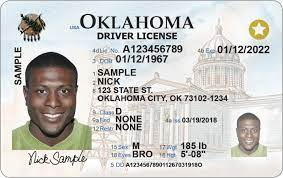Driver's licenses are essential identification documents that serve as proof of identity, age, and driving privileges for individuals across the United States. Each state has its own unique driver's license template, including Oklahoma. While these licenses may appear straightforward at first glance, they contain a wealth of information encoded within their design. In this article, we will take a closer look at the oklahoma drivers license template and decode the information it contains.
Understanding the Layout:
The Oklahoma driver's license template typically follows a standardized layout, with key information displayed in specific sections. At the top of the license, you'll find the state seal or emblem, along with the words "Oklahoma Driver License" or similar. Below this, the license holder's photograph is prominently displayed, usually on the left-hand side. Adjacent to the photo is the holder's personal information, including their full name, date of birth, and license number.
Decoding the License Number:
The license number printed on an Oklahoma driver's license contains valuable information that can be decoded to reveal specific details about the license holder. While the format may vary slightly over time, the general structure typically includes a combination of letters and numbers. The first few characters often represent the holder's last name, followed by numerical digits representing their birthdate or a unique identifier. By analyzing the license number, one can determine the approximate age and other details about the individual.
Analyzing the Barcode:
Embedded within the Oklahoma driver's license is a barcode containing encoded information about the license holder. This barcode is machine-readable and can be scanned by law enforcement officers, businesses, and government agencies to quickly access the holder's information. The encoded data may include personal details such as name, address, date of birth, license status, and expiration date. By decoding the barcode, authorities can verify the authenticity of the license and confirm the identity of the holder.
Examining Security Features:
Like all official identification documents, Oklahoma driver's licenses incorporate various security features to prevent counterfeiting and tampering. These features may include holographic overlays, UV printing, microprinting, and intricate background designs. Additionally, modern licenses may contain embedded RFID chips or other electronic security measures to enhance verification and authentication. By examining these security features, authorities and businesses can verify the authenticity of the license and detect signs of forgery.
Interpreting Classifications and Restrictions:
Oklahoma driver's licenses may contain specific classifications and restrictions that dictate the holder's driving privileges. These classifications typically indicate the type of vehicles the holder is authorized to operate, such as passenger cars, motorcycles, or commercial vehicles. Additionally, certain restrictions may be imposed based on the holder's age, driving record, or medical conditions. Understanding these classifications and restrictions is essential for law enforcement officers and businesses when interpreting and enforcing driving privileges.
In conclusion, decoding the Oklahoma driver's license template reveals a wealth of information about the license holder, including personal details, license status, and driving privileges. By analyzing key elements such as the license number, barcode, security features, and classifications, authorities and businesses can verify the authenticity of the license and ensure compliance with regulatory requirements. Understanding the intricacies of the Oklahoma driver's license template is essential for effective identification verification and maintaining the integrity of the state's licensing system.

